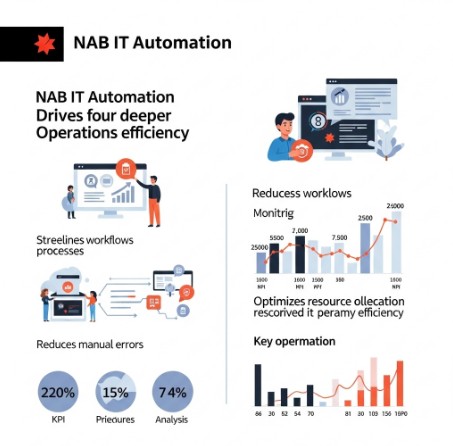In today’s rapidly evolving digital landscape, the pressure on IT operations to deliver seamless services and maintain high availability is immense. Manual processes are simply unsustainable, leading to increased operational costs, reduced agility, and heightened risk of errors. This is where NAB IT automation comes in as a crucial solution. This comprehensive guide delves into the world of IT automation within the National Australia Bank (NAB) context, exploring its benefits, challenges, and implementation strategies. We will examine how NAB leverages automation to enhance efficiency, improve security, and drive innovation across its IT infrastructure. Understanding NAB IT automation practices provides valuable insights for organizations seeking to transform their own IT operations.
Table of Contents
- 1 Understanding the Importance of IT Automation at NAB
- 2 Key Components of NAB IT Automation
- 3 Challenges in Implementing NAB IT Automation
- 4 NAB IT Automation: A Strategic Approach
- 5 Frequently Asked Questions
- 5.1 Q1: What are the key metrics used to measure the success of NAB IT automation?
- 5.2 Q2: How does NAB ensure the security of its automated systems?
- 5.3 Q3: What role does AI and Machine Learning play in NAB IT automation?
- 5.4 Q4: How does NAB handle the integration of new technologies into its existing IT infrastructure?
- 6 Conclusion
Understanding the Importance of IT Automation at NAB
National Australia Bank (NAB) is a major financial institution, handling vast amounts of sensitive data and critical transactions every day. The scale and complexity of its IT infrastructure necessitate robust and efficient operational practices. NAB IT automation isn’t just about streamlining tasks; it’s about ensuring business continuity, minimizing downtime, and enhancing the overall customer experience. Manual interventions, prone to human error, are replaced with automated workflows, leading to improved accuracy, consistency, and speed.
Benefits of NAB IT Automation
- Increased Efficiency: Automation drastically reduces the time spent on repetitive tasks, freeing up IT staff to focus on more strategic initiatives.
- Reduced Errors: Automated processes minimize human error, leading to greater accuracy and reliability in IT operations.
- Improved Security: Automation can enhance security by automating tasks such as vulnerability scanning, patching, and access control management.
- Enhanced Scalability: Automation allows IT infrastructure to scale efficiently to meet changing business demands.
- Cost Optimization: By reducing manual effort and minimizing errors, automation helps lower operational costs.
Key Components of NAB IT Automation
NAB IT automation likely involves a multi-faceted approach, integrating various technologies and strategies. While the specifics of NAB’s internal implementation are confidential, we can examine the common components of a successful IT automation strategy:
Infrastructure as Code (IaC)
IaC is a crucial element of NAB IT automation. It enables the management and provisioning of infrastructure through code, rather than manual configuration. This ensures consistency, repeatability, and version control for infrastructure deployments. Popular IaC tools include Terraform and Ansible.
Example: Terraform for Server Provisioning
A simple Terraform configuration for creating an EC2 instance:
resource "aws_instance" "example" {
ami = "ami-0c55b31ad2299a701" # Replace with appropriate AMI ID
instance_type = "t2.micro"
}
Configuration Management
Configuration management tools automate the process of configuring and maintaining IT systems. They ensure that systems are consistently configured to a defined state, regardless of their initial condition. Popular tools include Chef, Puppet, and Ansible.
Continuous Integration/Continuous Delivery (CI/CD)
CI/CD pipelines automate the process of building, testing, and deploying software applications. This ensures faster and more reliable releases, improving the speed at which new features and updates are delivered.
Monitoring and Alerting
Real-time monitoring and automated alerting are essential for proactive issue detection and resolution. This allows IT teams to identify and address problems before they impact users.
Challenges in Implementing NAB IT Automation
Despite the significant benefits, implementing NAB IT automation presents certain challenges:
- Legacy Systems: Integrating automation with legacy systems can be complex and time-consuming.
- Skill Gap: A skilled workforce is essential for designing, implementing, and maintaining automation systems.
- Security Concerns: Automation systems must be secured to prevent unauthorized access and manipulation.
- Cost of Implementation: Implementing comprehensive automation can require significant upfront investment.
NAB IT Automation: A Strategic Approach
For NAB, NAB IT automation is not merely a technical exercise; it’s a strategic initiative that supports broader business goals. It’s about aligning IT operations with the bank’s overall objectives, enhancing efficiency, and improving the customer experience. This requires a holistic approach that involves collaboration across different IT teams, a commitment to ongoing learning and development, and a strong focus on measuring and optimizing the results of automation efforts.
Frequently Asked Questions
Q1: What are the key metrics used to measure the success of NAB IT automation?
Key metrics include reduced operational costs, improved system uptime, faster deployment cycles, decreased mean time to resolution (MTTR), and increased employee productivity.
Q2: How does NAB ensure the security of its automated systems?
NAB likely employs a multi-layered security approach including access control, encryption, regular security audits, penetration testing, and robust logging and monitoring of all automated processes. Implementing security best practices from the outset is crucial.
Q3: What role does AI and Machine Learning play in NAB IT automation?
AI and ML can significantly enhance NAB IT automation by enabling predictive maintenance, anomaly detection, and intelligent automation of complex tasks. For example, AI could predict potential system failures and trigger proactive interventions.
Q4: How does NAB handle the integration of new technologies into its existing IT infrastructure?
A phased approach is likely employed, prioritizing critical systems and gradually expanding automation efforts. Careful planning, thorough testing, and a robust change management process are essential for a successful integration.

Conclusion
NAB IT automation is a critical component of the bank’s ongoing digital transformation. By embracing automation, NAB is not only enhancing its operational efficiency but also improving its security posture, scalability, and overall agility. While challenges exist, the long-term benefits of a well-planned and executed NAB IT automation strategy far outweigh the initial investment. Organizations across all industries can learn from NAB’s approach, adopting a strategic and phased implementation to maximize the return on investment and achieve significant improvements in their IT operations. Remember to prioritize security and invest in skilled personnel to ensure the success of your NAB IT automation initiatives. A proactive approach to monitoring and refinement is essential for ongoing optimization.
For further reading on IT automation best practices, you can refer to resources like Red Hat’s automation resources and Puppet’s articles on IT automation. Understanding industry best practices will help guide your own journey towards greater operational efficiency. Thank you for reading the DevopsRoles page!


